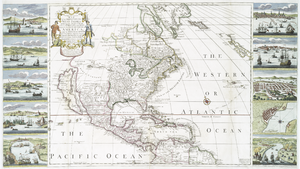War of Jenkins' Ear
| War of Jenkins' Ear | |||||||
|---|---|---|---|---|---|---|---|
| Part of the War of the Austrian Succession | |||||||
|
|||||||
| Belligerents | |||||||
|
|
|
||||||
| Commanders and leaders | |||||||
|
|
|
||||||
| Casualties and losses | |||||||
| 20,000 dead, wounded, missing, or captured, 407 ships lost |
4,500 dead, 5,000 wounded, 186 ships lost |
||||||
The War of Jenkins' Ear (known as Guerra del Asiento in Spain) was a conflict between Britain and Spain that lasted from 1739 to 1748, with major operations largely ended by 1742. Its unusual name, coined by Thomas Carlyle in 1858, refers to an ear severed from Robert Jenkins, a captain of a British merchant ship. Despite stories to that effect, there is no evidence that the severed ear was exhibited before the British Parliament.
The seeds of conflict began with the separation of an ear from Jenkins following the boarding of his vessel by Spanish coast guards in 1731, eight years before the war began. Popular response to the incident was tepid until several years later when opposition politicians and the British South Sea Company hoped to spur outrage against Spain, believing that a victorious war would improve Britain’s trading opportunities in the Caribbean. Also ostensibly providing the impetus to war against the Spanish Empire was a desire to pressure the Spanish not to renege on the lucrative asiento contract, which gave British slavers permission to sell slaves in Spanish America.
The war resulted in heavy British casualties in North America. After 1742, the war was subsumed by the wider War of the Austrian Succession, which involved most of the powers of Europe. Peace arrived with the Treaty of Aix-la-Chapelle in 1748. From the British perspective, the war was notable because it was the first time that a regiment of colonial American troops was raised and placed "on the Establishment" – made a part of the Regular British Army – and sent to fight outside North America.
At the conclusion of the War of the Spanish Succession in 1713, the Treaty of Utrecht gave Britain a thirty-year asiento, or contract-right, to supply an unlimited number of slaves to the Spanish colonies, and 500 tons of goods per year. This provided British traders and smugglers potential inroads into the traditionally closed markets in Spanish America. But Britain and Spain were often at war during this period, fighting one another in the War of the Quadruple Alliance (1718–20), the Blockade of Porto Bello (1726) and the Anglo-Spanish War (1727–1729).
...
Wikipedia

